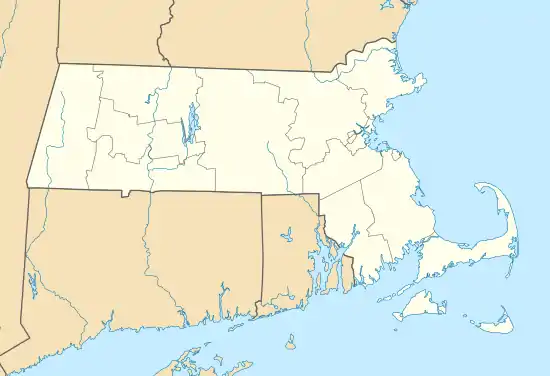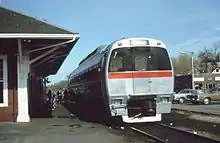Reading station (MBTA)
Reading is an MBTA Commuter Rail station in Reading, Massachusetts. It serves the Haverhill/Reading Line. It is located at Lincoln and High Streets on the western fringe of Reading's central business district. The station's historic depot building was built in 1870 by the Boston and Maine Railroad. The station was the terminus of the line from 1959 until the re-extension to Haverhill station in 1979.
Reading | |||||||||||
|---|---|---|---|---|---|---|---|---|---|---|---|
 Reading station viewed from the unused platform in 2014 | |||||||||||
| Location | 35 Lincoln Street, Reading, Massachusetts | ||||||||||
| Coordinates | 42°31′18″N 71°6′27″W | ||||||||||
| Owned by | MBTA | ||||||||||
| Line(s) | Western Route | ||||||||||
| Platforms | 2 side platforms | ||||||||||
| Tracks | 1 | ||||||||||
| Connections | |||||||||||
| Construction | |||||||||||
| Parking | Yes | ||||||||||
| Bicycle facilities | 10 spaces | ||||||||||
| Disabled access | Yes | ||||||||||
| Architectural style | Stick/Eastlake, Queen Anne | ||||||||||
| Other information | |||||||||||
| Fare zone | 2 | ||||||||||
| History | |||||||||||
| Opened | 1845 | ||||||||||
| Rebuilt | 1870 | ||||||||||
| Passengers | |||||||||||
| 2018 | 855 (weekday average boardings)[1] | ||||||||||
| Services | |||||||||||
| |||||||||||
Boston and Maine Railroad Depot | |||||||||||
  | |||||||||||
| Area | 3 acres (1.2 ha) | ||||||||||
| MPS | Reading MRA | ||||||||||
| NRHP reference No. | 84002509[2] | ||||||||||
| Added to NRHP | July 19, 1984 | ||||||||||
Architecture and history


The Boston and Maine Railroad Extension from Wilmington Junction to Boston was completed in 1845, with intermediate stops including Reading. A new station building was constructed in 1870.[3] The depot is located southwest of the tracks, at the junction of Lincoln and Prescott Streets. It is a long rectangular building with Queen Anne styling, with paneled pilasters at the corners and between the bays, and large knee braces that help support the wide overhangs of the hip roof. The north (track-facing) facade has seven bays, alternating windows (4) and doors (3). One of the windows is a projecting bay with a band of narrow and tall windows, whose upper sash has colored lights.[3]
The station was purchased by the town in 1960, and was briefly used as a museum of railroad history.[3] The MBTA purchased the Haverhill Line in 1973, intending to replace commuter rail service with extended Orange Line subway service between Oak Grove and Reading.[4] The new Reading/128 terminus would have been located outside the downtown area just south of Route 128, rather than at the current downtown location.[5] Ultimately, the extension was not built past Oak Grove due to rising costs, and commuter rail service was kept on the corridor.
The station was later rebuilt around 1991 with a mini-high platform on the inbound side for accessibility.[6][7] The second track, removed decades earlier, was not rebuilt; the outbound platform was repaired, but a second mini-high platform was not built. Thus, the inbound platform serves trains in both directions. Despite this limited capacity, Reading is the terminus for some local trains on the line.
The building was added to the National Register of Historic Places in 1984.[2] The town sold the building to private owners in 1985, with preservation restrictions.[3]
References
- Central Transportation Planning Staff (2019). "2018 Commuter Rail Counts". Massachusetts Bay Transportation Authority.
- "National Register Information System". National Register of Historic Places. National Park Service. April 15, 2008.
- "MACRIS inventory record and NRHP nomination for Boston and Maine Railroad Depot". Commonwealth of Massachusetts. Retrieved 2015-05-18.
- Belcher, Jonathan. "Changes to Transit Service in the MBTA district" (PDF). NETransit.
- Hanron, Robert (October 31, 1965). "THE M.B.T.A.: A Transit System Picks Up Speed". Boston Globe. p. C4. ProQuest 503454591.
- Operations Directorate Planning Division (November 1990). "Ridership and Service Statistics" (3 ed.). Massachusetts Bay Transportation Authority. p. 1–5 – via Internet Archive.
- MBTA : ACCESS; The Guide to Accessible Services and Facilities. Massachusetts Bay Transportation Authority. June 1992. p. 15 – via Internet Archive.
External links
![]() Media related to Reading station (MBTA) at Wikimedia Commons
Media related to Reading station (MBTA) at Wikimedia Commons

